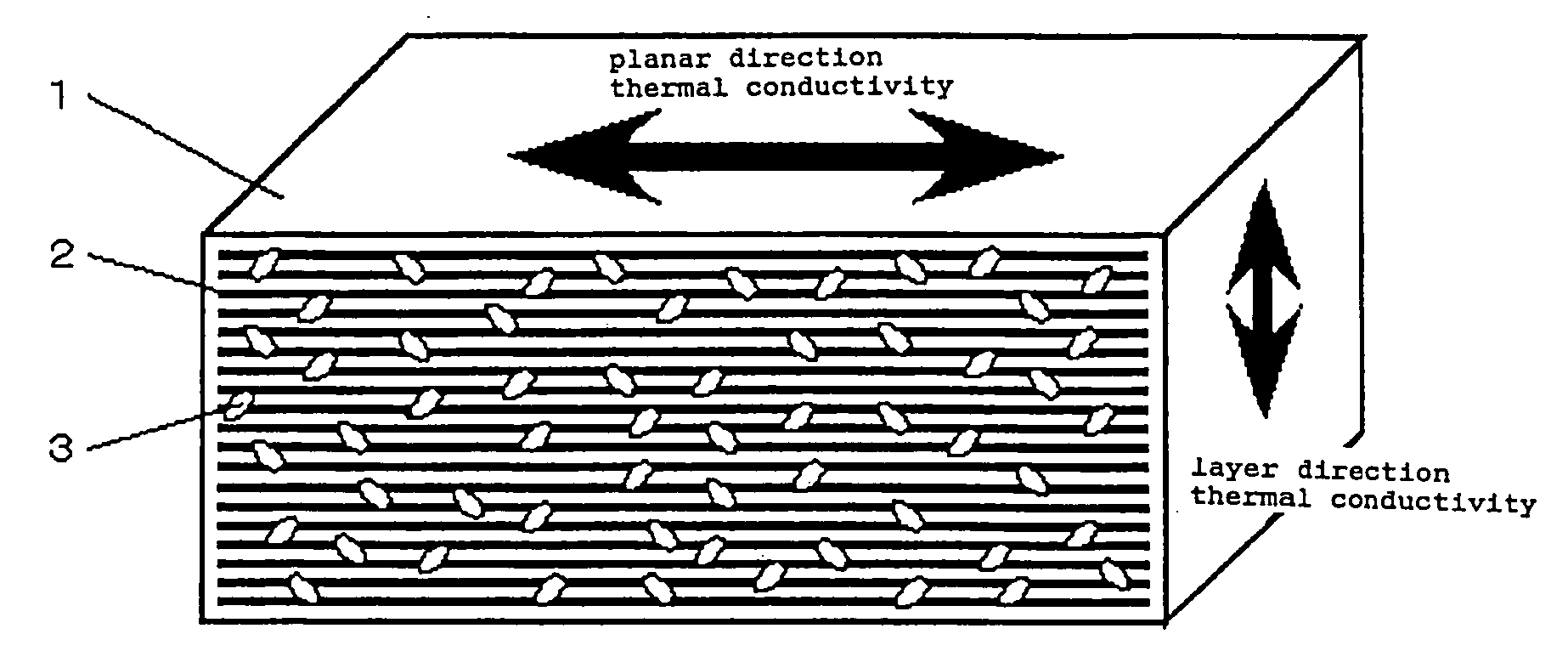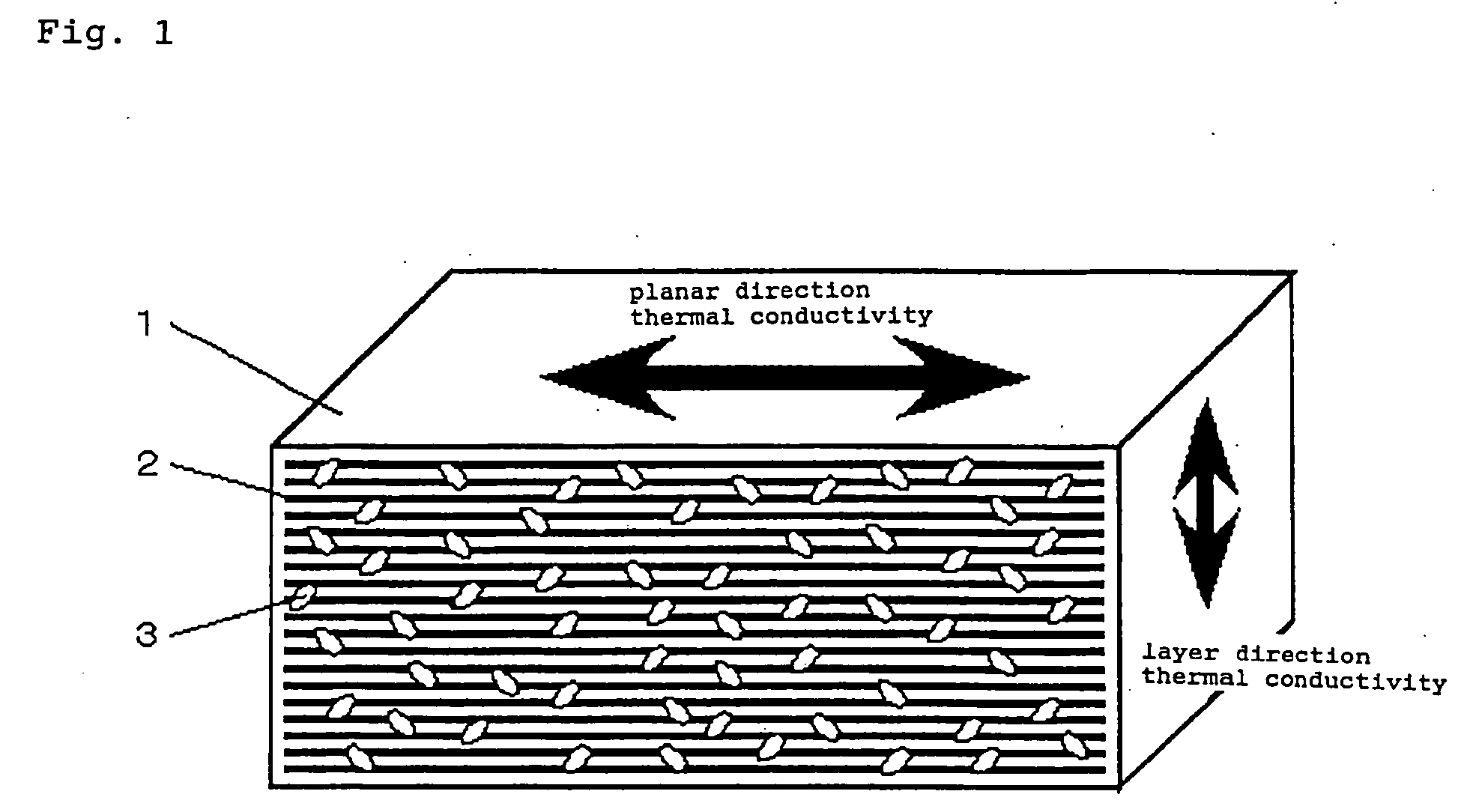High thermal conductivite element, method for manufacturing same, and heat radiating system
a technology element, which is applied in the direction of transportation and packaging, layered products, special tyres, etc., can solve the problems of difficult to achieve an overall high level of thermal conductivity, limited thermal conductivity of very roughly 20 to 30 w/mk, and insufficient realization of high thermal conductivity originally had by graphite, etc., to achieve high thermal conductivity, high thermal conductivity, and high thermal conductivity
- Summary
- Abstract
- Description
- Claims
- Application Information
AI Technical Summary
Benefits of technology
Problems solved by technology
Method used
Image
Examples
embodiment 1
[0153]FIG. 1 is a simplified diagram of the high thermal conductive element in Embodiment 1 of the present invention.
[0154] The main constituent elements of this high thermal conductive element are a graphite structure 1 whose c axis is oriented substantially parallel to the thickness direction, and graphite particles 3 that are dispersed substantially uniformly in the graphite structure 1.
[0155] This graphite structure 1 consists of interdependently stacked graphene layers 2 composed of carbon six-membered ring structures, as mentioned above. Specifically, an inherent property of graphite is that the graphene layers are not merely stacked, but are stacked in predetermined positions (see FIG. 4), and this positional relationship is maintained in the stacking.
[0156] It is preferable to use a graphite structure (graphite-based matrix) 1 with which evaluation by X-ray diffraction reveals a interplanar spacing d within a range of d=0.335 to 0.340 nm, and in which the (002) plane and ...
embodiment 2
[0164] The above-mentioned graphite structure 1 can be produced by several methods, but from the standpoints of ease of production, characteristics of the resulting high thermal conductive element, and so forth, it is preferable to employ a method in which the graphite structure 1 is formed by heat-treating an organic polymer.
[0165] The method for obtaining a high thermal conductive element composed of a graphite structure by using an organic polymer as the starting raw material roughly comprises (I) a step of obtaining an organic polymer in which graphite particles are dispersed, and (II) a step of heat-treating the obtained product to graphitize the organic polymer.
[0166] With the present invention, a polyimide can be used favorably as the organic polymer, for example. When the goal is a polyimide as the organic polymer, polyamic acid, which is a polyimide precursor, can be used as the raw material. In view of this, this method will be described as an example in Embodiment 2.
[0...
embodiment 3
[0178] As discussed in Embodiment 2 above, the high thermal conductive element of the present invention can be produced by using a pre-graphitized material as the carbon particles. In contrast, in Embodiment 3, the high thermal conductive element of the present invention is manufactured by pre-blending a precursor of carbon as the raw material for the carbon particles, then simultaneously graphitizing this precursor in the course of graphitizing the matrix in the above-mentioned step II, and dispersing the graphite particles in the graphite structure. An example of this will be described in this Embodiment 3.
[0179] The basic production steps may be the same as in Embodiment 2.
[0180] In step I, an organic polymer that is a precursor of carbon is mixed and dispersed in a first organic polymer solution dissolved in a solvent, and this product is put in a specific shape, after which the solvent is volatilized to solidify the material, and a dehydration reaction is conducted by heating...
PUM
| Property | Measurement | Unit |
|---|---|---|
| Temperature | aaaaa | aaaaa |
| Temperature | aaaaa | aaaaa |
| Temperature | aaaaa | aaaaa |
Abstract
Description
Claims
Application Information
 Login to View More
Login to View More - R&D
- Intellectual Property
- Life Sciences
- Materials
- Tech Scout
- Unparalleled Data Quality
- Higher Quality Content
- 60% Fewer Hallucinations
Browse by: Latest US Patents, China's latest patents, Technical Efficacy Thesaurus, Application Domain, Technology Topic, Popular Technical Reports.
© 2025 PatSnap. All rights reserved.Legal|Privacy policy|Modern Slavery Act Transparency Statement|Sitemap|About US| Contact US: help@patsnap.com



